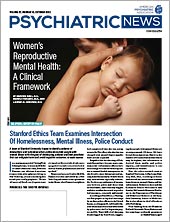Michael Fingerhood, M.D., has a patient in his 70s who has opioid use disorder. Usually alone when he uses, the patient told Fingerhood that he has started keeping naloxone in one hand so that as soon as he realizes he cannot handle the illicit drug he has just consumed, he can save his own life.
“Unfortunately, since the pandemic began, people are using alone, and older adults already deal with isolation and loneliness that make the problem only worse,” said Fingerhood, director of the Division of Addiction Medicine and professor of medicine and public health at Johns Hopkins University School of Medicine. He added that fentanyl has also played a significant role in increased drug deaths, as people with substance use disorders (SUDs) are unknowingly purchasing drugs with large amounts of fentanyl.
In its 2022 America’s Health Rankings Senior Report published earlier this year, the United Health Foundation reported that drug deaths among adults aged 65 and older doubled between 2008-2010 and 2018-2020, rising from 4.2 to 8.4 per 100,000, which corresponds to an increase of 8,620 deaths during this period. The report cited the Centers for Disease Control and Prevention’s Wide-ranging Online Data for Epidemiologic Research (WONDER) database.
The death rate among older adults due to drugs rose significantly in 35 states, according to the United Health report. The states with the highest increases include Connecticut (352%), Maryland (323%), and New Jersey (222%). Further, the report highlights clear disparities. The drug death rate was 10.4 times higher among Black adults compared with Asian adults, the group with the lowest rate, and the rate was twice as high among males compared with females.
“For older adults, one of the challenges is that substance use disorders are oftentimes overlooked when patients present with depressive symptoms or other conditions,” said Luming Li, M.D., M.H.S., an assistant professor adjunct in the Department of Psychiatry at the Yale School of Medicine and chief medical officer at the Harris Center for Mental Health and IDD (Intellectual and Developmental Disabilities).
She noted that the baby boom generation is more familiar with drug use and may be more likely to turn to drugs and alcohol to cope with symptoms of depression and loneliness compared with past generations of seniors. Further, the COVID-19 pandemic only worsened the problem, as public health measures cut off older adults from their social connections.
In 2019, Li and colleagues published a review and synthesis of the available literature on SUDs in later life, which they called “an emerging public health concern,” in the American Journal of Geriatric Psychiatry. They analyzed 124 documents, including government documents, studies, and review articles. “Evaluated studies and documents together suggest that older individuals are using illicit drugs and meeting criteria for SUDs at higher rates than previous geriatric cohorts, resulting in substantial negative impacts on medical and psychiatric conditions,” Li and her colleagues concluded in the study. “Current treatment models are inadequate to address the new wave of older individuals with SUDs.”
There are numerous biological factors that increase the odds of overdose among older adults, such as reduced metabolic clearance and the presence of a higher number of other medications in their systems due to comorbidities, explained Pallavi Joshi, D.O., a geriatric psychiatrist at Banner Alzheimer’s Institute and a clinical assistant professor in the Department of Psychiatry at the University of Arizona College of Medicine.
Biases against aging can lead to health care professionals overlooking SUDs, as well. Joshi pointed out that SUDs among adults over 65 can be difficult to diagnose because symptoms can mimic cognitive impairment. “Providers may dismiss or mistake confusion, forgetfulness, or falls as a sign of memory loss. If providers assume that cognitive impairment is a normal part of aging, then a substance use disorder that mimics this can be more easily overlooked.”
Nonetheless, there is hope for adults over age 65 who have an SUD, Joshi added. “Research shows that older adults respond well to SBIRT, or Screening, Brief Intervention, and Referral to Treatment,” she said. “Brief interventions can be done by any provider in any health care setting, and research shows that even older adults who are accepting of SBIRT can reduce consumption and misuse.”
She added that older adults are resilient, as evidenced by the COVID-19 pandemic: While the physical and social impacts were greater for older adults, they had better outcomes regarding suicide and other mental health metrics than younger adults, Joshi said. “We can use resilience to our advantage because a lot of these older folks have had to navigate difficult issues in the past.”
Fingerhood noted that he has seen more older adults seeking treatment for the first time in recent years, which he takes as an extremely positive sign. He emphasized the importance of screening in various settings, including primary care and emergency departments.
Yet there are numerous barriers to screening, he continued. “Stereotypes feed the belief that addiction isn’t a problem for older adults, and providers are less likely to screen them for substance use disorders,” he said. Further, many older adults may feel shame about their substance use that can cause them to hide it from their physicians, Fingerhood said.
Physicians should look for signs of substance use in older patients, who may be less likely to share information about themselves, and ask such questions as “Do you have trouble falling asleep?” “What do you do when you are alone? With friends?”, Fingerhood said. Additionally, he urged physicians to rescreen older patients following major life events, such as retirement or the death of a spouse.
Li emphasized the importance of connecting with older adults during treatment encounters. “In health care, especially hospital-based settings, you’re often focusing on the checklist of things you need to talk to that patient about,” she said. “But by not being present, you can miss important cues from patients. We need to approach [older] individuals with gentleness, care, and compassion to help them feel more connected so they are encouraged to develop healthy habits. A single good conversation can influence an older patient’s entire week.”
The 2022 America’s Health Rankings Senior Report is funded by the United Health Foundation. ■


